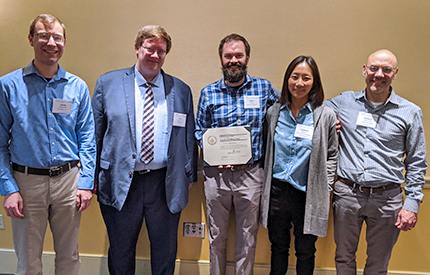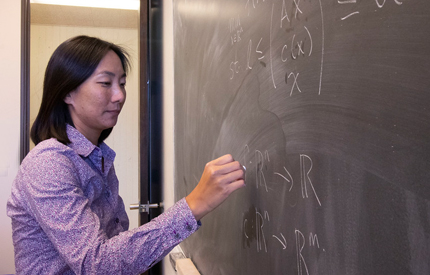Math Scientist Powers Up to Solve Energy Grid Problem
April 16, 2020 | By Cynthia Dillon
 From left to right, Team SNIP members include: Dan Molzahn (GA Tech), Kory Hedman (Program Director at ARPA-E), Frank E. Curtis (Lehigh), Elizabeth Wong (UC San Diego) and Andreas Wächter (Northwestern). Photo courtesy of Elizabeth Wong
From left to right, Team SNIP members include: Dan Molzahn (GA Tech), Kory Hedman (Program Director at ARPA-E), Frank E. Curtis (Lehigh), Elizabeth Wong (UC San Diego) and Andreas Wächter (Northwestern). Photo courtesy of Elizabeth Wong
Elizabeth Wong is a real GO-getter. The assistant project scientist in the UC San Diego Department of Mathematics was a member of an interdisciplinary and multi-institutional team that competed in the U.S. Department of Energy’s Grid Optimization (GO) competition. The team recently placed second out of 27 participating teams, winning $400,000 for continued research to ramp up the U.S. power grid.
Wong and her colleagues Frank E. Curtis, Lehigh University; Daniel Molzahn, Georgia Tech and Andreas Wächter, Ermin Wei and Ruby Tushen, Northwestern University, used their collective expertise in optimization, power systems and network analysis to design an optimization algorithm and software for a challenging power grid problem. The team’s portion of the total $3.4 million purse will be used to further develop its approach and pursue industry adoption of its technology. If successful, the GO competitors will further the development of advanced software to enable a responsive, resilient and efficient American power grid.
The fellow competitors named their team “GO-SNIP”—“GO,” after the competition title, and “SNIP” for a combination of the two pieces of nonlinear optimization software that the team anticipated using, SNOPT and IPOPT. Each use a different algorithm to solve the same type of optimization problem. SNOPT was originally authored by UC San Diego Professor of Mathematics Philip Gill and former colleagues at Stanford University. Currently, he and Wong maintain SNOPT on campus. IPOPT is authored by Andreas Wächter, a GO-SNIP team member.
 UC San Diego Department of Mathematics Assistant Project Scientist Elizabeth Wong. Photo by Michelle Fredricks, UC San Diego Physical Sciences
UC San Diego Department of Mathematics Assistant Project Scientist Elizabeth Wong. Photo by Michelle Fredricks, UC San Diego Physical Sciences
“I think the success of our team in this competition can be attributed to the interdisciplinary nature of our team. Everyone on the team was essential, and we had expertise in all of the right areas,” said Wong. “My own research is in nonlinear optimization, which has applications in many areas, but I often do not get to see these applications first-hand. This competition was a great experience with a very challenging problem, and it was really exciting to work closely on a real application of the work I do.”
Managed by the DOE’s Advanced Research Projects Agency-Energy (ARPA-E), the GO competition is a series of challenges to accelerate the development and comprehensive evaluation of new software solutions for the energy grid of the future. Key areas for development include but are not limited to optimal utilization of conventional and emerging technologies, management of dynamic grid operations (including extreme event response and restoration) and management of millions of emerging distributed energy resources (DER).
Wong and her teammates met the challenge posed by ARPA-E to develop an algorithm to address the electric power sector's security-constrained optimal power flow (SCOPF) problem. If ARPA-E poses additional challenges, the team can qualify to further evaluate its first challenge’s solution by accounting for complicating factors such as larger network models, optimizing power flows over transmission and distribution systems, stochastic optimization and leveraging power flow control devices.
According to the DOE, existing grid software was designed for a power grid based on conventional generation and transmission technologies which are dominated by large, centralized power plants. The rapid development in recent years of new resources, including DERs, intermittent resources (e.g., wind and solar) and storage, has created a new set of challenges for grid management.
 Elizabeth Wong demonstrates working a problem. Photo by Michelle Fredricks, UC San Diego Physical Sciences
Elizabeth Wong demonstrates working a problem. Photo by Michelle Fredricks, UC San Diego Physical Sciences
Currently, grid management software does not allow for new forms of generation and storage to be used fully. Existing grid software makes several simplifying assumptions that produce suboptimal power flow solutions, resulting in increased electricity costs. The effects of these assumptions grow as the number of DERs grows. Furthermore, increasing emphasis on grid resilience requires innovative management of more diverse and decentralized resources, which existing grid software is not equipped to handle.
Innovation is needed regarding the underlying modeling, optimization and control methods to increase grid flexibility, reliability and resilience. In addition to reducing system costs and barriers to fully integrated new technologies, the impacts of optimization software include boons to security, the environment and the economy.
